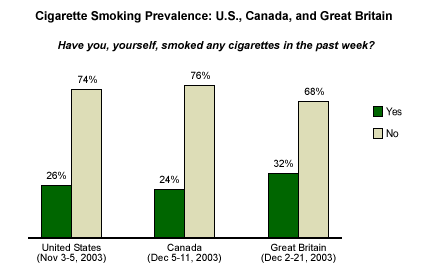Tobacco use, which the World Health Organization calls the "leading cause of preventable deaths in the world today," is reportedly responsible for almost 4.9 million deaths per year around the world. WHO views tobacco as the most dangerous consumer product available, and the only legal consumer product that "kills through normal use." While Gallup trends show that smoking is on the decline, many around the world continue to smoke.
Gallup data from a recent three-country survey* suggest that about a quarter of U.S. adults (26%) and Canadian adults (24%) smoke cigarettes. Smoking is slightly more prevalent in Great Britain, where 32% of adults reported smoking cigarettes in the past week.

Trends
Historical Gallup data show that cigarette smoking in the United States, Canada, and Great Britain has declined over the past 40 years. However, the decline is greatest in Canada -- the percentage saying they have smoked in the last week has dropped 28 points, from 52% in 1974 to 24% today. The percentage of Canadians who say they smoke is currently as low as it has ever been during the 40-year trend, which may reflect the recent enactment of tougher legislation on smoking in public and higher taxes on cigarettes. In the United States, 40% of adults reported smoking in 1974, compared with 26% today -- a far more modest decline. In Great Britain, smoking prevalence has also experienced a 14-point drop since 1974 -- from 46% in to 32%.
Demographics
The prevalence of cigarette smoking is the same for men and women in each country, but a look at Gallup's data broken out by age group confirms the ongoing concern that younger people are continuing to light up. Thirty-eight percent of young British adults (aged 18 to 34) reported smoking in the last week, while 29% of young Canadians (aged 18 to 29) and 28% of young American adults (aged 18 to 29) said they had smoked.
WHO estimates that about half of children in the world are exposed to secondhand smoke at home. In Great Britain and in Canada, adults in households with children present are at least as likely to be smokers as those who do not have children in the household.

Bottom Line
In May 2003, WHO adopted an international treaty for tobacco control -- the first legal document aiming to reduce the number of worldwide tobacco-related deaths and diseases. This treaty, once ratified, will help nations establish additional laws and restrictions on the use of tobacco products. The Gallup data show that while there have been significant declines in the incidence of smoking, there is still much work to be done.
*Results for the United States are based on telephone interviews with 1,007 national adults, aged 18 and older, conducted Nov. 3-5, 2003. For results based on the total sample of national adults, one can say with 95% confidence that the maximum margin of sampling error is ±3 percentage points.
Results in Canada are based telephone interviews with 1,012 national adults, aged 18 and older, conducted Dec. 5-11, 2003. For results based on the total sample of national adults, one can say with 95% confidence that the maximum margin of sampling error is ±3 percentage points. The survey was conducted by Gallup Canada.
Results in Great Britain are based telephone interviews with 1,000 national adults, aged 18 and older, conducted Dec. 2-21, 2003. For results based on the total sample of national adults, one can say with 95% confidence that the maximum margin of sampling error is ±5 percentage points. The survey was conducted by Gallup UK.
Results for the Canada and Great Britain surveys may not equal 100% due to rounding error.
In addition to sampling error, question wording and practical difficulties in conducting surveys can introduce error or bias into the findings of public opinion polls.